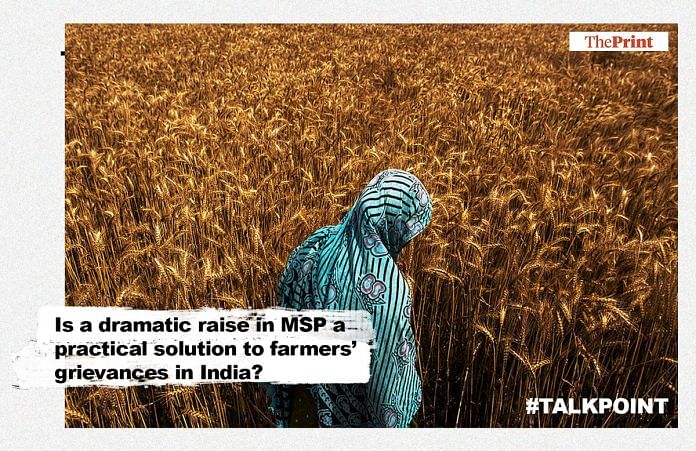Thousands of farmers marched in Delhi on Monday, demanding a one-time full loan waiver, fair crop prices and the fulfilment of the Centre’s promises to them. PM Narendra Modi had promised a minimum of 50% profits over the cost of production during the 2014 election, based on the recommendation of the National Commission of Farmers chaired by Prof. M S Swaminathan. In 2015, the Centre dropped the proposal stating it may lead to market distortion.
ThePrint asks: Is the Swaminathan committee recommendation on MSP a practical solution to farmers grievances in India?
At the advent of Green Revolution itself, the government had realised that substantial increase in production of wheat will result in crash of market prices. Therefore, the Food Corporation of India (FCI) and Agriculture Prices Commission were set up in 1965.
The agricultural commodities arrive in the market at the end of a cropping cycle and the farmers generally sell their produce to meet their household expenditure and to prepare for next crop. The prices around this period are at their lowest. The central government, therefore, fixes MSP for 24 crops based on the recommendation of CACP. The data for CACP is collected by the Department of Agriculture through field units, mostly affiliated to state agricultural universities.
Generally, the data is two years old and it is extrapolated by CACP to arrive at the current year’s cost. Since the cost varies across the states, the CACP arrives at a weighted average. It is, however, important to remember that cost of production is not the sole criterion considered by CACP. It also takes into account demand-side factors and global prices.
The MSP declared by the government is, however, implemented on the ground primarily for wheat and paddy and that too in few states. It is only in case of sugarcane that the farmers receive the equivalent of MSP, called fair and remunerative price (FRP). In some years, other crops like cotton and ground-nut are also procured at MSP. A recent evaluation study by Niti Ayog (2016) has found that 81% of farmers were aware of MSP.
Here are other sharp perspectives on Swaminathan committee recommendation on MSP :
P. Chengal Reddy: Chief Advisor, Consortium of Indian Farmers Association
Yogendra Yadav: National President, Swaraj India.
Vijay Sardana: Commodity Markets & Agribusiness Strategist
Aruna Urs: farmer-in-residence.
The demand of farmers organisations to implement National Commission for Farmers (Swaminathan Commission) recommendation by fixing MSP at C2 cost plus 50 percent has so far not been accepted by the government as it will result in across-the-board increase in MSP, and the government will not be in position to procure at such rates, which are likely to be much higher than market rates. MSP of paddy, for example, would be Rs 2226 per quintal in place of current MSP of Rs 1550 (43 percent higher) if Swaminathan formula is applied. In Kharif 2017-18, not a single crop has its MSP at C2 plus 50 percent. In case of several crops like ragi, jowar, moong, etc. the MSP is lower than even the C2 cost.
MSPs at such high levels would result in prices of most Indian agricultural commodities being much higher than global prices.
It would therefore be impractical to expect the government to procure all 24 commodities at such high MSPs across the country. It is also debatable if it will be prudent and desirable to enact a law forcing the APMCs to not allow any sale at prices lower than MSP.
Price controls at such massive scale would require intervention of bureaucracy at the level of every mandi which would breed corruption everywhere. Ultimately the agri-trade has to be enabled to function in an open environment in which there is fair competition. A number of other measures are, however, necessary to make farming profitable but the Swaminathan formula does not entirely provide the answer to these challenges.
The government has been putting a number of restrictions from time to time on purchase, storage, trading, import and export of agricultural commodities, which have resulted in lower prices for farmers. In several states, the taxes and levies were more than 14 percent. The need of the hour is to declare a ten-year policy for agricultural trading so that a stable regime is used by governments and the trade to create infrastructure needed for marketing and storage of agri-commodities.
Siraj Hussain is a Visiting Senior Fellow, ICRIER.







Owing to a bumper crop of wheat the Modi govt should immediately take steps to curb import of wheat a stagnant price over nine months due to heavy imports has affected small and medium farmers who did not sell wheat in may and june to make a extra buck but large scale imports have affected farmers who stocked grain adversely if there is a bumper crop import restrictions should be imposed to keep the business spirit high within the country and encourage stockist to invest in farming.